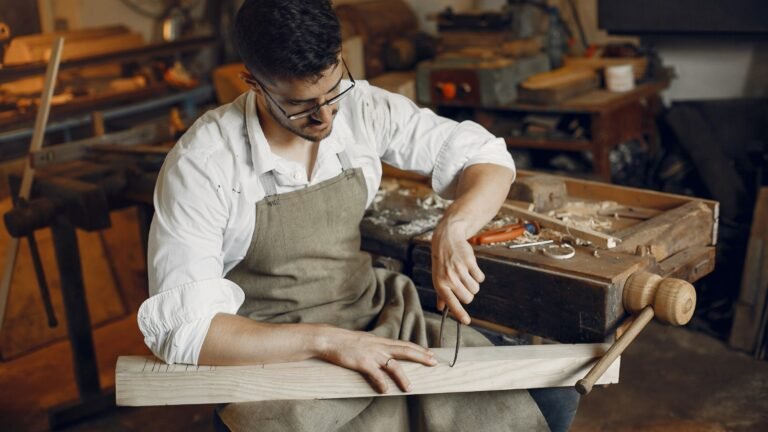
The Role of Premium Materials in Elevating Handmade Furniture
Handmade furniture carries a presence that mass-produced pieces rarely achieve. Each curve, joint, and finish reflects the time and intention of the maker. Yet beyond craftsmanship, what truly sets such creations apart are the materials. The selection of premium materials does not just influence how furniture looks. It defines its strength, longevity, and the way it interacts with a space over time. In this sense, premium materials become the quiet yet undeniable force behind the impact of handmade furniture.
Why Materials Matter Beyond Aesthetics
Designers and artisans know that wood, stone, glass, or metal are not merely components. They are the very foundation on which quality rests. Choosing the right material changes how furniture feels under the hand, how it ages across years of use, and how it communicates character to those who live with it.
In high-end interiors, materials are never a secondary thought. They shape the story of the piece. Oak speaks of durability, walnut whispers warmth, marble adds gravitas. When combined with the precision of an artisan, they turn simple objects into heirlooms.
The Value of Premium Materials in Handmade Furniture
Premium materials offer more than surface-level beauty. They contribute three essential qualities:
1. Longevity
Handmade furniture is expected to last for decades, sometimes generations. Durable hardwoods, high-quality metals, and tempered glass ensure that the structure remains strong, resisting the wear and tear that often shortens the life of mass-produced alternatives.
2. Consistency in Craft
When artisans work with materials of a higher grade, they achieve finer detailing and smoother finishes. Knots, irregularities, or weaknesses are minimized. This allows for sharper joins, more seamless lines, and furniture that feels complete in every angle.
3. Timeless Appeal
Premium finishes do not just endure, they mature. A well-oiled oak table gains a deeper hue over time. A leather seat develops a patina unique to its use. These gradual changes add authenticity and story to the piece, something that cannot be replicated in factory-made designs.
Wood as the Soul of Artisan Furniture
Among all materials, wood holds a special place in the world of unique handmade furniture. The species chosen often signals the intent behind the piece.
- Oak: Strong and versatile, oak balances grain character with durability. It works beautifully in both contemporary and traditional designs.
- Teak: Valued for its resistance to moisture and decay, teak is often chosen for outdoor or transitional spaces.
- Walnut: Known for its rich, dark tones, walnut is a favorite for modern yet grounded interiors. It resists warping and offers a natural luster.
- Maple: With its lighter color and fine grain, maple offers a cleaner, understated elegance.
Each wood brings not just a look but a feeling. Artisans often spend years mastering how to cut, cure, and finish each type to reveal its best expression.
The Subtle Power of Stone, Metal, and Glass
While wood is the backbone, other premium materials elevate artisan furniture products into something more striking.
- Stone: Marble, onyx, or granite inserts in tables or consoles add permanence. They introduce a natural patterning that makes every piece one-of-a-kind.
- Metal: Brass, bronze, or stainless steel can be integrated into legs, trims, or frameworks. The sheen and strength of metal act as both structure and ornament.
- Glass: Modern handmade furniture often embraces glass for its ability to reflect light and lighten heavier forms. Textured or tinted glass adds another layer of depth.
When these materials are blended thoughtfully, the result is a balance of weight and refinement. It is never about decoration alone but about harmony in design.
The Artisan’s Relationship With Material
Materials of high quality demand skill. They resist shortcuts and reveal flaws when handled carelessly. That is why artisans often speak of working with the material rather than simply shaping it. The grain of wood might dictate the curve of a chair arm. The natural veining of stone may influence the positioning of a tabletop.
This respect for raw elements is what differentiates handmade furniture from industrial production. Machines cut with efficiency, but artisans carve with intuition. When given premium materials, their artistry rises even further.
Investing in Handmade Pieces
For many homeowners, investing in handmade furniture built with premium materials is both a design decision and a lifestyle choice. These are pieces that do not go out of style with changing trends. Instead, they grow with the home, absorbing memories and meaning.
Buyers also notice subtle differences:
- The weight of a solid wood table versus a veneer.
- The cool touch of natural marble compared to composite stone.
- The resilience of handstitched leather against synthetic fabric.
Such details define the daily experience of living with furniture. They are less about show and more about quiet satisfaction.
A Modern Appreciation for Material Integrity
In recent years, there has been a growing demand for authenticity in interiors. Customers no longer seek only shapes and finishes. They want to know where the wood was sourced, whether the leather is ethically treated, and how the stone was cut. Transparency adds value, especially in the world of artisan furniture products.
This awareness has also encouraged makers to innovate while staying true to material integrity. Reclaimed wood, eco-conscious finishes, and responsibly mined stone are increasingly woven into the luxury furniture narrative. It proves that premium does not only mean rare or expensive, it also means considered and respectful.
Conclusion
The magic of handmade furniture lies in the meeting of craft and material. Without premium materials, even the most skilled hand cannot achieve the same impact. With them, every detail, every curve, every polished surface speaks of purpose and permanence.
Choosing such pieces is not just about design. It is about welcoming longevity and character into a home. In a world of fast turnover and disposable items, handmade furniture built with premium materials stands as a quiet but powerful reminder of what endures.



